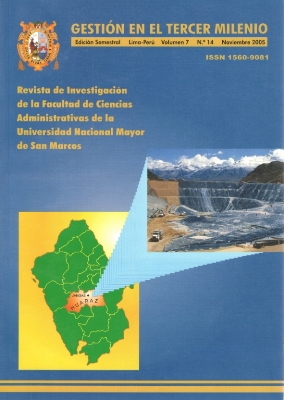EMPRESARIALIDAD DE NUEVAS EMPRESAS DE HUACHO Y HUAMANGA
DOI:
https://doi.org/10.15381/gtm.v7i14.9788Keywords:
Entrepreneurs, enterprises, development, Huacho and HuamangaAbstract
Objetives: This study has as an objective to identify the principal factors that influence on the process of formation of new enterprises and the advancement within different local contexts, as well as how to know and evaluate the factors that affect the success of new enterprises in Huacho and Huamanga in order to priorize the actions that the governments have to do to promote the enterprising. Method: So as to know the factors that affect the success in the new enterprises and to learn how the entrepreneurs can manage their businesses, 81 manufacturing owners were interviewed in Huacho and Huamanga. Results: There are important contrasts: The entrepreneurs are specially 31 year-old women in Huacho and men in Huamanga, whose high-level studies were concluded or not. These people formed their enterprises when they were between 20 and 30 years of age, using personal savings to open their business. They got experience, competence, business abilities and above all long lasting contacts. The business out of Huamanga is more difficult than the business in Huacho due to the lack of finance, the bureocracy and the high costs. Conclusion: It is inferred that the areas that require policies to promote enterprising and the peculiarities of the enterpreneuring process in each region consider the following aspects: one is the global aspect over the objectives and the strategic importance of the supporting policies to the enterprising and the other is on how to promote enterprises in the studied areas of Huacho and Huamanga.Downloads
Published
Issue
Section
License
Copyright (c) 2005 María Celina Huamán Mejía

This work is licensed under a Creative Commons Attribution-NonCommercial-ShareAlike 4.0 International License.
THE AUTHORS RETAIN THEIR RIGHTS:
(a) The authors retain their trademark and patent rights, and also over any process or procedure described in the article.
(b) The authors retain the right to share, copy, distribute, execute and publicly communicate the article published in Gestión en el Tercer Milenio journal (for example, place it in an institutional repository or publish it in a book), with acknowledgment of its initial publication in the Gestión en el Tercer Milenio.
(c) Authors retain the right to make a subsequent publication of their work, to use the article or any part of it (for example: a compilation of their work, lecture notes, thesis, or for a book), provided that they indicate the source. of publication (authors of the work, magazine, volume, number and date).













